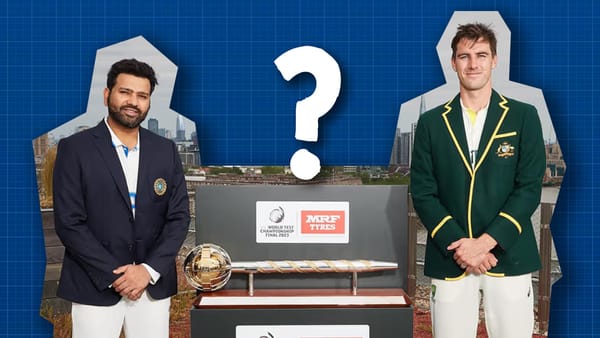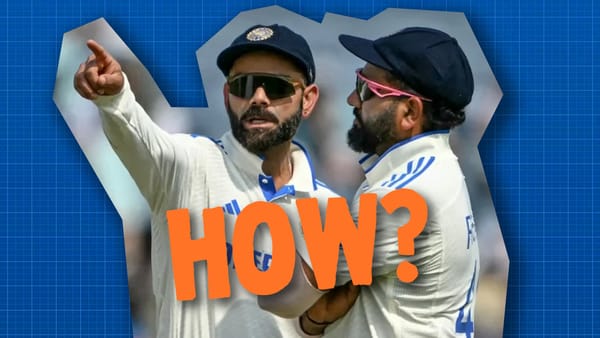India's day-nightmare
The collapse and the pain.
"It's not going to stop." Aimee Mann, Wise up, December 10, 1996.
The short ball is 140.8 KPH. Mohammed Shami is not playing a shot, though he wanted to. He had grand plans of a pull as he swayed into position. But what happened was too quick, too accurate, there was no time, room, or space. His body is frozen into place, his head has already left though. The head gets the danger, the body doesn't, meaning that the ball slams into his naked arm. It hits the bone, making a breaking noise. He stumbles from the wicket, the bat keeping him from falling.
There is magic spray applied, but the physios don't have a good enough use of their alchemy. This would require real magic, not just a bottle with a funny name. Instead, they strap up the arm, hoping to keep the limb in place. They use a vivid blue bandage. The strapping is bright, the only thing that is.
The pain, it's not going to stop.
-
First ball of the day is fast, straight, it tails back at the stumps, and the Australians are screaming already. The second ball is more of a moan as a quarter shot is played by Mayank Agarwal outside off stump. A boundary is struck soon after, in the air, but safe.
Next over the nightwatchman Jasprit Bumrah mis-hits one through the offside and takes some runs. It would never be an easy morning, but this is ok, doable.
But there is a bouncer, the coldest cup of coffee. Bumrah is now diving and running in the same motion. Australia smiles, Bumrah smiles, and next ball the ball is pushed back to Cummins. India has lost a predictable first wicket. Australia smiles, Bumrah doesn't.
The commentators wonder how flat the pitch is. A gentle conversation, there is no menace intended. This has been a difficult wicket. While fans have been screaming for quicker rates, batsmen have been hanging on. It's not an obvious tricky pitch. The ball hasn't gone sideways, you can still play basic shots. But until the ball gets soft, everything is just hard. Driving is impossible, pulling is tough, deliveries have kept low for LBWs and the outside edge never seems far away. Tricky pitches are usually more obvious, you can see the damage coming. This pitch is like Covid, you don't see the problems, but the numbers are clear.
A few balls later and Pujara's off stump is targeted by Cummins, and the delivery takes the outside edge. When Cummins is like this, you don't go anywhere. You are trapped. When he has a pitch that helps him, you won't often see the ball jag about, he doesn't do exaggerated movement. He knows where your off stump is, and he wants it. Again, and again, someone this fast shouldn't be this accurate. It's unnerving.
And the respite at the other end is someone a bit taller who gets more movement. Josh Hazlewood does nothing different from his normal programming. Just outside off stump, slightly back of a length. This is a standard Hazlewood over. He's bowled this thousands of times, and so often it doesn't get a single wicket. This time he gets two.
India's best shot is an inside edge past leg stump from a leave. At drinks, neither Cummins or Hazlewood look tired. There will be no Nathan Lyon or Cameron Green, at best, it will only be Mitchell Starc and his 90+ left arm. It's clear, it's not going to stop.
-
There are different collapses. One where the number ten ends up in the middle of the ground stil strapping his thigh pad. They happen so fast that the changeroom is a panic. Someone is throwing their kit. Two others are changing quickly back into their whites while the coach is whispering with a young player in a corner. People raise their voices. "Where's my bat tape?" "What, another one?" "You better be quick". "Just be positive". "Get us through to lunch". These shouted half-sentences fill the air, but no one hears them.
And there's the slower collapse. It's like watching a car accident in slow motion. It doesn't feel as hectic, it's just none of you can change it. Someone mentions batting on off stump, but, that fades into a whisper mid-sentence. Another says they can still rally, noting the ball got soft in the previous innings. But no one answers. There is just a lot of staring.
Only the Indians will know which one this as. Three wickets in 10 balls, but it also felt like a slow burn. It didn't feel like every ball would a wicket, but at times there almost was. It felt like every ball would be good, maybe great. Every ball would be at them, relentless. It didn't matter what pace it happened, because it was not going to stop.
-
It's a drive, but barely. The muscle memory has taken over. That's a weird phrase because there is nowhere in the muscle to keep a memory. What really happens is doing the same thing repeatedly leaves an imprint of that movement in your brain. When a ball is full outside off stump at 90 miles per hour, the mind has 200 milliseconds. A blink takes at least 300, so the brain takes the first option and prepares you for the cover drive. That is your shot, and your foot goes out to meet the length of the ball, your hands cock and then flow through, and by the time you question yourself, the best you can do is turn a full drive into a push.
But maybe it wasn't that at all. You had stopped this shot in the first innings, you know it is possible. But back then you were in charge of your faculties. It was tough, but Rome wasn't burning around you. Right now, you need to make a mark. This is your only Test, this is your last innings of this series. You are Virat Kohli, you are the last guy left, this is all about you. You. You. You. You know this probably isn't the time or place for a cover drive, but you have to try something. Because otherwise, it's not going to stop.
-
Mohammed Shami is shaking his hands as he gets to the crease. He looks down at his fingers, they are no longer being controlled. The fingers tremble as he stares down at them. Quake, shiver. Shami's determined to go on, but he walks away from the crease to compose himself. He makes it back to the pitch, gets back into a stance, but the hurt is still there. He leaves the wicket again, calling back on the medical team.
The physio comes out, and there is no magic spray, because there is no magic. Shami keeps going back to his stance, hoping that something will change. Like if he can just get his hand to hold the bat up, he can do something for India. A few runs, a slog or two, some stolen singles. Any runs might be enough. The physio knows he can't bat, but his words probably do less than when he twists Shami's arm. The arm isn't working. It won't work again today.
Umpire Bruce Oxenford - who has spent much of his time looking worried - now turns to the Australians. It's possible he's heard Shami say he can't go on, but it almost seems as if Oxenford's calling it. Like a referee in a boxing ring. His hand gesture is the global message for it's off.
Shami never turns around to the umpires or the Australians. He picks up his bat and tucks it under his working arm and leaves the field.
"No, it's not going to stop
So just give up"
🎙🎙New Red Inker out now🎙🎙
— Jarrod Kimber (@ajarrodkimber) 9:32 AM ∙ Dec 16, 2020
Why are Mumbai Indians so good with Ben Jones
anchor.fm/redinker/episo…
Mumbai is just so much better than every other IPL team. Leadership, strategy, drafting, positions, middle order, and the rest.
On the eve of the Australia-India Test series, I spoke to the brilliant @ajarrodkimber about my lifelong love for cricket:
— Ramachandra Guha (@Ram_Guha) 4:30 AM ∙ Dec 16, 2020




